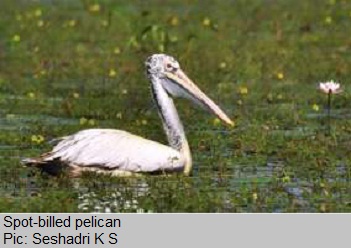Any and all opinions expressed in
this newsletter are solely those of the author(s) and do not reflect the opinion of ATREE.
Centre for Excellence
in Conservation Science
Royal Enclave,Srirampura,Jakkur
Post
Bangalore-560064
Telephone: 080-23635555 (EPABX)
Fax : 080- 23530070
In the gradient of a common man's natural
progression to a serious birder, whose
access to Protected Areas (PA) is restricted,
birds around one's courtyard, paddy field or
the nearby pond/lake plays a crucial role in
honing one's bird-watching skills during
those formative years. And I am no
exception. But the interesting part, at least in
my case, is that even after I have had access
to several PAs in the last few years, the fascination with those that exists beyond
them, is still strong. While working in KMTR
for the last 5 years I also got ample
opportunities to watch birds that existed
beyond the reserve, mostly through the
annual 'water fowl census' that ACCC
organises every winter. It was during these
surveys that I could master my field
identification skills of the waders. And the
wetlands that the great river Tamiraparani
supported in the landscape are
literally 'treasure troves' of bird
diversity , particularly the aquatic
ones. During the survey, we
encountered about 60 species of
wetland birds including a few
species like black bittern, pied
avocet which are not very common
in the area. Many are winter
migrants for whom these wetlands
are critical source of food and
shelter. However, most wetlands are threatened today , as the article by Allwin and
Mathivanan in this issue highlights. Birds,
even those occurring beyond the PA, should
be conserved and protected, mainly from the
threats of local poaching, which, if goes
unchecked for a long time, can pose serious
survival challenge for them. Many people,
even those who live in close vicinity with
these birds and have come to know about
their intrinsic values such as being natural
pest controllers and natural fertilizing agents,
still seek them out and persecute them by
bursting crackers, shooting with catapult,
setting snares and traps and by stealing
eggs. Thus it wouldn't be entirely wrong to
suggest that if protected areas allegedly
alienate people, even the people outside
such areas appear to alienate themselves
from the rich diversity of life in and around
them, for reasons beyond the
comprehension of a passionate birder like
me.
Editorial
Team
Editor: Allwin
Jesudasan
Associate editor: Rajkamal
Goswami
Editorial Review: R.
Ganesan, M. Soubadra Devy, T. Ganesh
Design and presentation:
Kiran Salagame
A S H O K A T R U S T F
O R R E S E A R C H I N E C O L O G Y A N
D T H E E
N V I R O N M E N T
The joy of bird watching in a rural landscape
- Seshadri K S
If you have any suggestions or comments
please let us know through the boxes below






